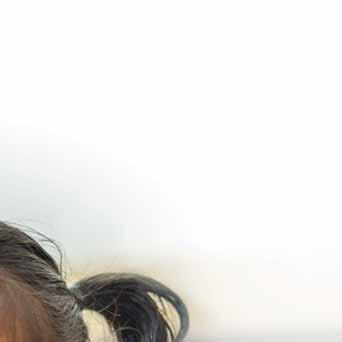
17 minute read
Mending little hearts, the Sanjeevani way
Rasheeda Bhagat
Ibelieve we are trustees of the wealth god has given us; before we were born it belonged to someone else, after we die, it will go to someone else, says Vivek Gour, one of the three trustees of the Sri Sathya Sai Health and Education Trust, which runs three dedicated paediatric heart surgery centres in India. Named the Sri Sathya Sai Sanjeevani Centres for Child Heart Care, these are located in Raipur, Chhattisgarh; Palwal, near Faridabad in Haryana; and Navi Mumbai.
Advertisement
Gour, a Rotarian, and a member of RC Gurgaon Harmony Iberis, RID 3011, says this without any swagger, while explaining that a few years before his death, the Sai Baba had asked his devotee C Sreenivas to set up five heartcare hospitals to provide completely free heartcare to children. “Sunil Gavaskar, and I, also his devotees, joined Sreenivas to realise this dream. We have already set up three centres, and will be putting up two more,” he adds. All of them have contributed towards setting up these hospitals, which provide totally free medical treatment to children born with congenital heart defects (CHD).
Over three years ago, Gour took early retirement from his business in aviation engineering; and put all his time, energy and passion into running these hospitals.
Totally, about `150 crore has been invested in the three hospitals, with money coming from “philanthropists, Rotary clubs including global grants, and CSR funds.” He estimates that around $2.5 million has come from Rotary, “including GGs and clubs sponsoring children for surgery.”
It is estimated that each year 3 lakh children are born in India with CHD and thanks to the dearth of healthcare facilities, and poverty, 1 in 4 of these children do not see their first birthday.
A child with a CHD stays at these hospitals for two weeks, and “her parents can enter without a single naya paisa in their pockets, get their child diagnosed, treated/operated and leave the hospital with no tension about money for subsequent treatment
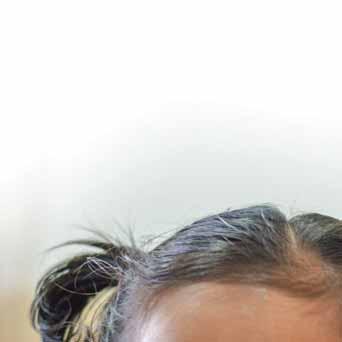
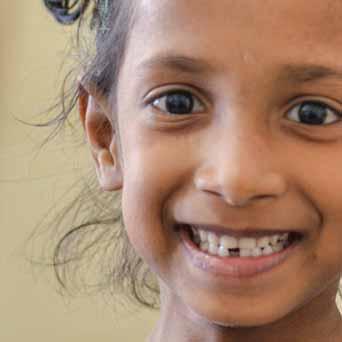
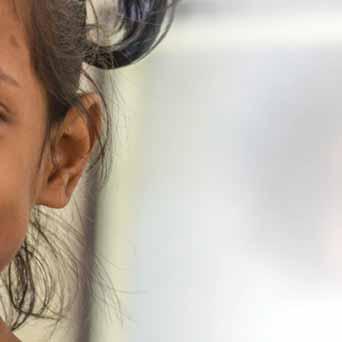


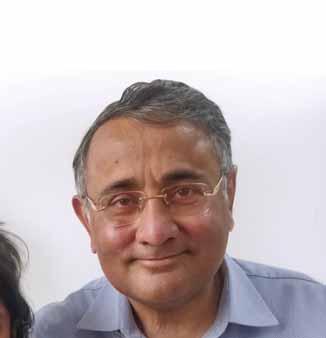
if required. Often, several procedures are needed to cure the child. And with only three trustees, decisions are made fast.”
On the doctors and other staff getting market rate salaries, he says: “Well, they get normal salaries, which can’t be compared with something close to `6 crore a year being paid in large private hospitals. But those salaries come with the stiff target the surgeon has to meet. Last year, when my mother was admitted in a Delhi hospital, I met a surgeon who earned… I bet you’ll fall off your chair… `13 crore a year!”
Their doctors, he adds, get paid a “decent wage”, and accommodation. But the biggest reward for them is not having to turn away a patient for being too poor, something they had to do often in private hospitals, “knowing very well that the child will die without the surgery that the parents cannot afford. And being human beings, that distressed them a lot.”
Now the institution is nearly 9 years old; for the first three years they got patients by word of mouth. “Today many doctors who can’t provide them relief say aap Sathya Sai baba mei chaley jaon.” With even those with moderate means having at least a smartphone in the family, we are googled. Also, government hospitals, where the poorest of poor go first, refer patients. “We get children from almost every corner of India… Mizoram to Kashmir to Kanyakumari; our waiting list now is 4,000.”

Vivek Gour, trustee, Sri Sathya Sai Health and Education Trust, with a child. 4-year-old Ivannah from Tanzania.

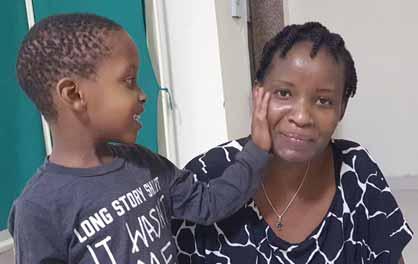
“We don’t turn away anybody, and have also treated children from 14 developing countries such as Pakistan, Afghanistan, Nepal, Bangladesh, Sri Lanka, Fiji, Uzbekistan, Nigeria, Yemen, Ethiopia, Iraq etc. We have conducted four international child heart missions in Fiji and Nigeria.”
He adds that since commencement in 2012, these centres have managed over 135,000 paediatric cardiac outpatients and performed over 16,000 open heart
surgeries and non-invasive catheter
interventions on children, which would cost between `2–7 lakh in
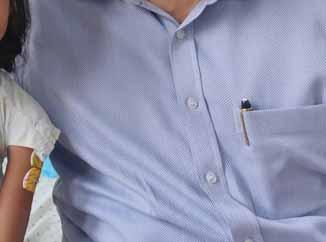
private hospitals, but here the cost is only `1.5 lakh.
RI director Mahesh Kotbagi is most impressed by their “zero-rupee concept.” He visited the Raipur hospital, along with RI President Shekhar Mehta, PRID Kamal Sanghvi and Rajya Sabha MP Vivek Tankha, in August, when Mehta inaugurated an oxygen plant donated by
RC Raipur Royal, RID
3261, at a cost of `1 crore, through a TRF global grant.
A doctor who runs his own hospital in Pune, Kotbagi says that normally a paediatric surgery to repair a CHD costs around `5 lakh, “including pre-surgery diagnostics, battery of tests, lab services, cath intervention, blood, medicines and consumables, surgery, hospital stay and postoperative cost. But here it costs only `1.5 lakh.”
He adds, “I have compared this hospital with many others that do charitable work, but no centre comes anywhere close. They have 150 beds in the Raipur Hospital, 125 in Palwal in Haryana and 75 in Khargar, near Navi Mumbai.” In a typical month, the Sanjeevani hospitals do between 350 to 500 surgeries; 500 was average but in the last 18 months, due to Covid, the numbers went down. “This is a huge challenge, if you consider that a paediatric surgery in a neonatal intensive care unit is very challenging.” Some children are barely a few days, or weeks old, and “can’t talk or tell the doctor that I am breathless.”
The nursing in a paediatric surgical unit is “not normal ICU nursing, but a 24x7, highly specialised job right from changing a nappy or sponging the child to feeding her,” says Kotbagi.
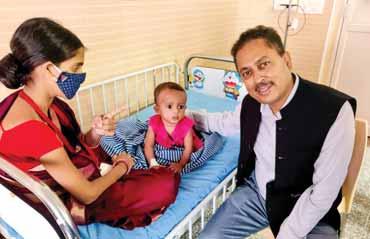
Complex heart surgeries are also done here; “even if the child is now 20, we still do the surgery, but of course such cases are very rare. Because most of those children die before they reach 20,” says Gour. Their youngest patient was a one-week-old child; many children require multiple surgeries, and “we know if we don’t do it, nobody else will and the child will die,” says the trustee.
I next ask Gour about the gender mix in the children being brought for surgery, because we know that in many homes saving a boy’s life matters more than saving a girl. He says that though they roughly see 60 per cent boys compared to girls, “quite often, we find many women, and I am ever so proud of them, who come alone with their girl child, often with their own mothers, seeking treatment because the father and his family have abandoned the child as she was born with a CHD.”
Sadly enough, he adds, they also see family reunions after the child’s heart has been repaired! The father then comes back and reclaims the child.
Iattend the “gift of life” ceremony that the Sanjeevani hospitals do for all the children who go home after their hearts
RI Director Mahesh Kotbagi visits an operated child.
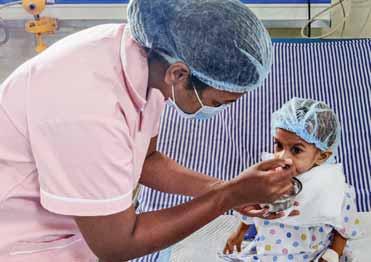
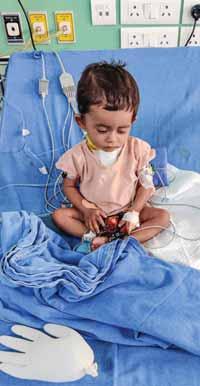
have been mended. Aaliya Fatima, from Palamu in Jharkhand, is a little over 3 years old. When she was just one month old, she had an eye problem and while being checked for that, her CHD was diagnosed. “They
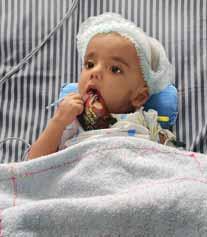
A child from Kurdistan, Iraq, treated at the hospital. were told that it would cost `6.5 lakh for the surgery. She is the fourth child, and her father Javed Ahmad owns a small shoe shop; the family simply did not have the money for the surgery,” says Ravikumar Sreepadha, who is the Trust officer for the Raipur centre.
Aaliya got operated upon on Aug 10, and was ready to go home in 10 days, and once her family doctor gives the green signal, will start going to school.
Dakshita Sharmita’s story is heartwarming; when her mother Jyoti was pregnant, the sonograph showed some problem in the foetus’s heart. The child was born a robust 3kg-baby, but when she completed 3 months, she started having severe cold and cough episodes. An Echo, We don’t turn away anybody, and have also treated children from 14 developing countries, and have conducted four international child
heart missions in Fiji and Nigeria.
Vivek Gour
Trustee, Sri Sathya Sai Health and Education Trust
done at a medical college hospital, revealed a big hole in her heart. The family came from Hisar district in Haryana and the father, Ramesh Sharma, worked as a mechanical engineer in Mumbai. They were told an immediate operation was required, so they rushed to a large private Mumbai hospital where the tag for the surgery was put at `10–20 lakh, a sizable advance demanded, and the risk put as “very high”. Another hospital in Bengaluru put the cost at `7 lakh as a complex surgical procedure was required.
Around this time the parents got a Whatsapp message telling them about the Sri Sathya Sai Sanjeevani hospital in Raipur. They brought the child here, were told that “while there was risk, the team would try its best to make her fine,” adds Sreepadha.
The surgery was done successfully in Nov 2015; “she had a very stormy
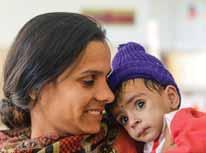
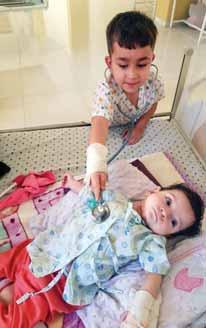
A brand new heart
Once the operations have been done, follow up is done diligently… after one month, six months or a year or even two years later, depending on individual cases. Two of the three children, who had been operated here, have grown up and even got jobs at one of the hospitals; a 21-yearold has become a lab technician, says trustee Vivek Gour! He adds, “Once the child has gone back home, we call once a year for 3–4 years to find out how the kid is doing. Is she going to school, etc; 100 per cent go back to school and lead a healthy life.”
He puts it succinctly when he explains: “My heart is 60 years old and filled with all the ghee, oil and chocolates I’ve eaten for 60 years. But a 3 or 6-month child’s heart is pure and clean, and has trouble only because of a congenital or engineering defect. When that defect is corrected then it functions like a brand new heart. So, within a week the child is running around the ward, playing football, the mother can’t control him because after 2 or 3 years the child has found that energy for the first time in his life.”
A Rotary gift for 124 children, costing `2 crore
RID Mahesh Kotbagi, who visited the Sanjeevani hospital in Raipur, along with RI President Mehta, was so impressed by the ethos of the Sanjeevani hospitals… “can you imagine that they do not turn away a single child, and have the concept of walk-in patients”... that he spontaneously made a far-reaching announcement. “Our president, Shekhar Mehta, turns 62 this October. The best gift I can give him is sponsoring 62 free heart operations to celebrate his birthday. Shekhar was very touched, and he said if Mahesh is doing 62, I will match with another 62 sponsored surgeries.” With the average cost of each surgery pegged at around `1.5 lakh or so, this will mean a project of `2 crore from Rotary. “I appeal to individual Rotarians and clubs through Rotary News to sponsor one or more children, as this is really a mind-blowing service project. The GG option is there too but I am not depending too much on it, as it is very popular and there is so much demand on it, but we can also approach corporates for CSR funds.”
He said he was very heartened by the fact that in “two days, when I told some friends that I want to save some children’s lives, can you help… it will cost `1.5 lakh, and you will get tax exemption, I got 20 sponsors from both Rotary and outside Rotary.”
Kotbagi said that while he went around the wards, he met one Kenyan mother and her child. “For a free paediatric heart surgery, East African countries have a waiting period of 8–10 years. A Kenyan woman, who’d come to India to get her child operated was referred here and she was amazed to get it done totally free.”
He added: “Anybody who wants to give sanjeevani amrut to save a child’s life can contact me to sponsor a child, and meet our target of saving the lives of 124 (62+62) to celebrate President Shekhar’s 62nd birthday.”
He adds a poignant moment from his life as a doctor. “Once on a medical mission in East Africa, I asked a woman about the prevalent racism against blacks in Africa, and she said, “I don’t know what is a black or a white human being. I only know that when I delivered a child it was a blue baby (with a CHD or hole in the heart), but in the same street, the same day, another woman delivered a pink baby (with a normal heart). So, I only know the difference between a blue (ill) baby and a pink (healthy) one.”
A unique concept at this hospital, given the terminology “working meditation” is that over the years, the parents of the children, who have little to do as their daughters or sons are taken care of by the hospital staff, have started volunteering. So, while Dileshwar’s mother made rotis in the kitchen, many of the fathers, some skilled farmers, helped out in the garden. Yet others keep the floors and the toilets clean; those with skills in plumbing or electrical appliances help in carrying out associated repairs. Says Kotbagi, “This is a novel concept that has simply evolved over the years…. The new set of parents watch the older parents helping out and automatically volunteer to do what they know best… cook, clean, or grow vegetables!”
Rotary has had a close association with Sanjeevani and Kotbagi adds that being a trust hospital, the Sanjeevani centres are open to all kinds of help from Rotarians and others. “You can donate, give equipment; recently I found that an all-women’s club RC Raipur Queens, have just built a beautiful auditorium at the Raipur campus. On one floor there is a place of worship, with no images or idols. Anybody of any faith can offer a prayer here. The structure is a beautiful prism and the totally empty hall, where anybody can say any prayers, radiates peace and calm.”
RI President Shekhar Mehta and Rashi visit a child at the hospital.

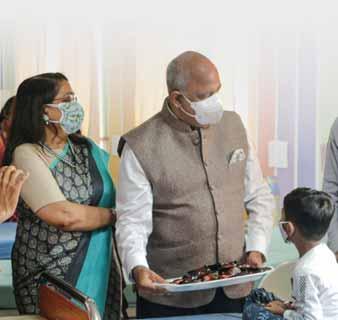
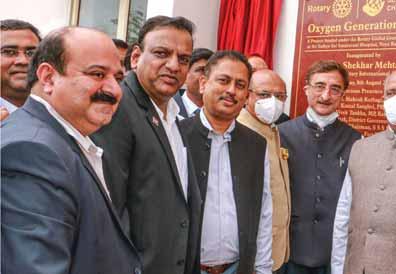
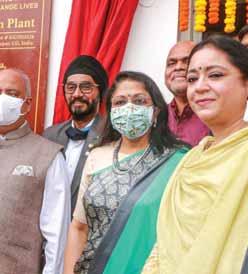
RI President Shekhar Mehta inaugurating an oxygen generation plant at the Sai Sanjeevani Hospital in Raipur in the presence of (from R) Rajjo Saini, Rashi, PDGs Ranjeet Singh Saini, Vivek Tankha, PRID Kamal Sanghvi, RID Mahesh Kotbagi and DGE Shashank Rastogi.
post-operative period. She was frequently extubated and re-intubated, underwent tracheostomy and was eventually weaned off the ventilator.” She was discharged from hospital on Feb 8, but not “before her birthday was celebrated with the entire Sai Family! The father said: ‘We really don’t have the heart to go home; the love we found here, we can’t dream of getting anywhere else’.”
Little Dileshwar is also ready to return home after his heart has been repaired, and his grateful parents, as they receive the certificate, look visibly relieved. His father, Meghnand Makhi is from the notoriously poor belt of Kalahandi in Odisha. He works as a driver and he and his wife were devastated, when they took Dileshwar, now 7 but then only 18 days old, to a doctor when he was running a fever, and were told that the child had a “heart condition”. They were asked to take him to a big hospital; a
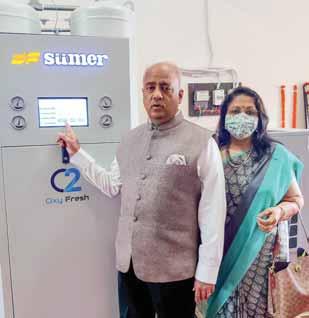
Normally a paediatric surgery to repair a CHD costs around `5 lakh, but here it costs only `1.5 lakh. I have compared this hospital with many others that do charitable work, but no centre comes anywhere close.
Mahesh Kotbagi
RI Director relative told them about Sanjeevani, and they brought him here in 2016. Recently he was operated upon and he has started to go to school.
On the role played by Gavaskar, Gour says: “He plays a huge role in raising funds and he is with us because he is a devotee; we have known him from earlier on too. That he is a cricket celebrity is the icing on the cake.”
For the next two centres, these trustees are looking for a city in Eastern UP or Bengal as “we find maximum concentration of children requiring our help in UP, Bengal, Bihar and Jharkhand as the population density is greater there. If we can get some land, these centres can come up.”
Designed by Krishnapratheesh S
At Rotary, we understand that cultivating a diverse, equitable, and inclusive culture is essential to realising our vision of a world where people unite and take action to create lasting change.
We value diversity and celebrate the contributions of people of all backgrounds, across age, ethnicity, race, colour, disability, learning style, religion, faith, socioeconomic status, culture, marital status, languages spoken, sex, sexual orientation, and gender identity as well as differences in ideas, thoughts, values, and beliefs.
Recognising that individuals from certain groups have historically experienced barriers to membership, participation, and leadership, we commit to advancing equity in all aspects of Rotary, including in our community partnerships, so that each person has the necessary access to resources, opportunities, networks, and support to thrive.
We believe that all people hold visible and invisible qualities that inherently make them unique, and we strive to create an inclusive culture where each person knows they are valued and belong.
In line with our value of integrity, we are committed to being honest and transparent about where we are in our DEI journey as an organisation, and to continuing to learn and do better.
Download a copy of Rotary’s commitment to DEI at
rotary.org/dei.
In Rotary, we celebrate diversity, equity, and inclusion. It doesn’t matter who you are, who you love, how you worship, whether you have a disability, or what culture or country you (or your family) are from. All that matters is that you want to take action to create lasting change.
Rotary is working to ensure that everyone sees us as a just and welcoming organisation. Diversity has long been one of our core values, and we’re proud of the organisation we’ve built. But there’s more we can do to exemplify diversity, equity and inclusion (DEI); to expand our ability to reflect the communities we serve; and to respond to our communities’ needs.
Based on input from our DEI Task Force, Rotary International’s Board of Directors strengthened the DEI statement we adopted in 2019. The result is a heightened commitment to diversity, equity, and inclusion focused on celebrating everyone’s contributions, advancing equity, and creating an inclusive culture where each person knows they are valued.
Diversity, equity, and inclusion are not political issues. Each of us has the right to be treated with dignity and respect, to have our voices be heard, and to access the same opportunities to succeed and lead at Rotary. Our members consistently tell us that being a welcoming organisation is vital to our future and that by being diverse and inclusive is how we’ll remain the preeminent place for people of action to connect with one another and make a difference.
We look forward to your continued support as we make Rotary more diverse, equitable and inclusive, ensuring that everyone who engages with Rotary knows they are valued and belong.
Shekhar Mehta RI President, 2021-22
Share our updated statement about Rotary’s commitment to DEI with your members via email or at a club meeting.
Post the updated statement to your club website and social media accounts, and link to it in your club’s email signatures.
Use the statement to discuss how your club can be more diverse, equitable, and inclusive for current and future members.
Encourage your fellow members to be respectful of one another and speak up when a person’s actions don’t reflect our ideals and values.
Expand your knowledge by taking a DEI course in the Learning Center.
Jennifer Jones RI President, 2022-23




